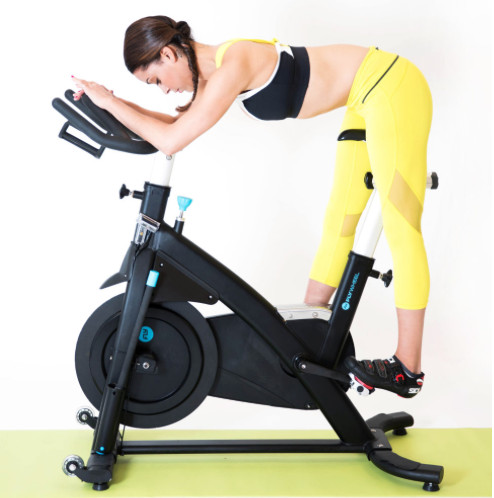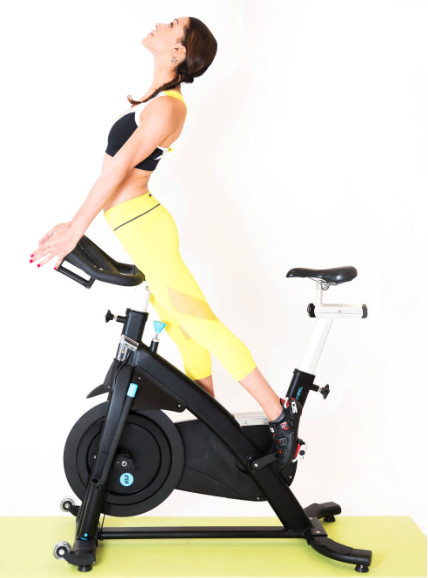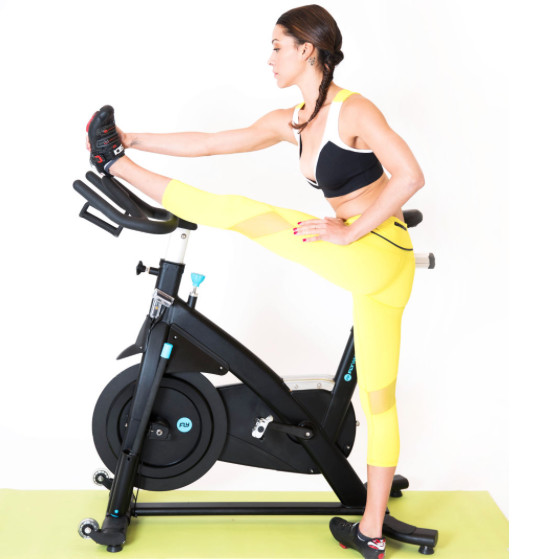You might have seen articles promoting stretches you can do right on your Spinning Bike Indoor Cycle. Perhaps you’ve even incorporated them into your classes. But as a seasoned indoor cycling instructor, I’m here to tell you that stretching on your bike during a class is a risky practice that can lead to injuries and potential liability.
Recently, a popular magazine featured an article titled “The Only 5 Stretches You Need To Do After Indoor Cycling.” While the intention might be to promote post-workout flexibility, some of the suggested on-bike stretches are simply dangerous, especially in a group spinning bike indoor cycle setting.
With years of experience teaching Spinning® since 1996 and educating instructors worldwide, I’ve always emphasized that stretching on a spinning bike, specifically targeting the lower body, is a no-go. Instructors should especially avoid the precarious hamstring stretch that involves throwing your leg over the handlebars. The risk of injury is significantly amplified when guiding a class full of participants, where close supervision of each individual’s form and safety is nearly impossible.
Of course, if you’re cycling solo and want to experiment with these stretches on your own spinning bike indoor cycle, that’s your prerogative. However, leading a class through these movements is irresponsible. Participants trust instructors to guide them safely and effectively. There are safer and more effective off-bike stretches that target the same muscle groups without the added risks.
While standing quad and hip stretches are generally acceptable, the first three stretches highlighted in the aforementioned article are particularly concerning. Let’s examine why.
Stretch #1: Calf and Back Stretch on the Spinning Bike
 stretch – calves on bike
stretch – calves on bike
This stretch, performed by flexing forward while seated on the spinning bike indoor cycle with pedals horizontal, might seem innocuous at first glance. However, when weight is applied to the pedals in this position (3 and 9 o’clock), it generates considerable torque on the crank arms in opposing directions. While this might be less of an issue for lighter individuals, it places significant stress on the bike’s components, particularly the cranks, for heavier riders exceeding 200 lbs. Therefore, even if participants are unconvinced about the stretch’s efficacy for their calves, instructors can discourage it based on the potential damage to the spinning bikes.
Furthermore, this calf stretch is less effective for riders using standard toe-strap pedals, as opposed to clipless pedals. Those clipped in can achieve a deeper stretch. Newer participants often don’t tighten toe straps adequately, unintentionally excluding themselves from this purportedly beneficial stretch. A more inclusive and safer approach is to perform calf stretches standing off the spinning bike indoor cycle, ensuring everyone can effectively participate.
A real-world incident underscores the dangers of on-bike stretching. An instructor recounted how a rider, known for disregarding safety instructions, leaned excessively backward during this calf stretch. The handlebars, either improperly tightened or faulty, detached from the bike. The rider fell heavily, still clipped in, landing forcefully on their tailbone. This incident, fortunately without severe injury, serves as a stark reminder of the unpredictable nature of equipment and rider behavior in a spinning bike indoor cycle class.
Another instructor shared a similar near-miss where a participant almost tumbled off the back of their spinning bike indoor cycle. Imagine the potential for serious injury if a rider were to fall onto the handlebars or flywheel of the bike behind them! Why introduce such avoidable risks when safer stretching alternatives exist?
Stretch #2: The “Titanic” – An Upward Dog on Your Spinning Bike
 stretch – titanic vertical
stretch – titanic vertical
This stretch, often referred to as the “Titanic” or an “upward dog” on the handlebars, represents an even greater leap into danger and absurdity on a spinning bike indoor cycle. It is exceptionally risky, particularly within a large group fitness setting. Even experienced cyclists using clipless pedals can encounter unexpected unclips. Personal experience highlights this – during a recent class, my shoe unexpectedly unclipped. Had I been performing a “Titanic” stretch with toes pointed down, a broken ankle would have been a distinct possibility.
Beginner indoor cycling participants often lack a complete understanding of clipless pedal mechanisms, sometimes mistakenly believing they are securely clipped in when they are not. Imagine an inexperienced rider attempting this precarious stretch – the likelihood of unclipping and falling is significantly heightened. Moreover, heavier individuals could potentially rip cleats from their shoes if the cleats are even slightly worn, adding another layer of risk.
The pelvic region is highly sensitive for everyone. The potential for injury in this area during a fall from this position is considerable. Why place yourself in such a vulnerable situation on a spinning bike indoor cycle?
Furthermore, handlebar security is not always guaranteed. Riders may neglect to adequately tighten handlebar adjustments. Performing this “upward dog” stretch against loosely secured handlebars on a spinning bike indoor cycle is a recipe for disaster.
Incidents of handlebar failures are not uncommon. Years ago, a loud crash during a post-class stretch (off-bike) revealed that a rider’s handlebars had completely collapsed due to an unsecured pop-pin. While thankfully no one was injured then, imagine if such a failure occurred while someone was leaning their full weight over the handlebars in the “Titanic” position on their spinning bike indoor cycle.
Stretch #3: The Leg-Over-Handlebar Hamstring Stretch on a Spinning Bike
 stretch – foot on bars
stretch – foot on bars
While some individuals with exceptional flexibility might execute this leg-over-handlebar hamstring stretch on a spinning bike indoor cycle without immediate incident, it’s fraught with danger for most. Participants often feel pressured to emulate the instructor, even if their flexibility is lacking. This can easily lead to loss of balance and falls, potentially sideways onto another bike or backward. These aren’t hypothetical concerns; instructors have reported actual instances of riders falling during this stretch in their spinning bike indoor cycle classes. One such incident reportedly resulted in a substantial lawsuit due to a participant’s serious injuries.
Beyond the safety risks, the effectiveness of this particular hamstring stretch is questionable. A more effective and safer hamstring stretch can be achieved using the lower crossbar of the spinning bike indoor cycle. By placing your foot on the crossbar and gently leaning forward, tilting your tailbone back, you can achieve a deep and satisfying hamstring stretch without the balance and fall risks associated with the leg-over-handlebar version. Try this safer alternative – you’ll likely find it superior.
High Risk Equals High Liability in Your Spinning Bike Indoor Cycle Studio!
Instructors who lead classes in these risky on-bike stretches are exposing themselves and their studios to significant liability. If a participant is injured performing these instructed stretches, legal repercussions are a real possibility. Lawsuits against instructors and studios are not uncommon, and studios often bear the brunt of the financial responsibility.
Don’t underestimate the potential for legal action. People will sue if they are injured doing stretches that YOU, the instructor, directed them to perform on a spinning bike indoor cycle. The potential financial and reputational damage is simply not worth the risk. There are demonstrably safer, more effective, and less liability-laden ways to stretch off the bike.
In a future article, I will detail and demonstrate the safest and most effective stretches to incorporate after your spinning bike indoor cycle classes.
Please share this article widely with fellow instructors and studio owners. It’s crucial to raise awareness about the liability associated with ill-advised on-bike stretches and prioritize participant safety in every spinning bike indoor cycle class.
